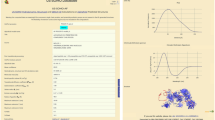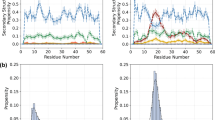Abstract
The α-helix defined in 1951 by Pauling et al.1 on the basis of model building and X-ray fibre diffraction data has 3.65 residues per turn (n) achieved with planar peptides, torsion angles of φ = −48° and ψ = −57° and hydrogen bonds which are close to linear. Although X-ray analyses of proteins have confirmed the general correctness of the model for the helix, recent high resolution (1.7–1.0 Å) diffraction studies have shown that the parameters described by Pauling et al.1 and later by Perutz2 and Arnott and Wonacott3 are not a good description of the α-helices in globular proteins4–7, where the mean values of φ, ψ, are usually close to −63°, −42°. Here we show that these values arise as a mean of two significantly different classes in amphipathic helices depending on whether the peptide carbonyl oxygen is hydrogen bonded to a solvent or polar side-chain atom. The hydrogen bonds made by the hydrophilic carbonyls to the NH groups within helices are longer and less linear than those involving hydrophobic carbonyls. We also show that these effects are associated with a significant curvature of helices in globular proteins. For example, the α-helix in avian pancreatic peptide (aPP) has a radius of curvature of approximately 70 Å. These results are of significance in the packing of helices in fibrous and globular proteins, in the calculation of their dipole moments, solvent accessibilities and internal energies, and in the theoretical estimation of spectroscopic properties such as circular dichroism and Raman scattering.
This is a preview of subscription content, access via your institution
Access options
Subscribe to this journal
Receive 51 print issues and online access
$199.00 per year
only $3.90 per issue
Buy this article
- Purchase on Springer Link
- Instant access to full article PDF
Prices may be subject to local taxes which are calculated during checkout
Similar content being viewed by others
References
Pauling, L., Corey, R. B. & Branson, H. R. Proc. natn. Acad. Sci. U.S.A. 37, 205–211 (1951).
Perutz, M. F. Nature 167, 1053–1054 (1951).
Arnott, S. & Wonacott, A. J. J. molec. Biol. 21, 371–383 (1966).
Glover, I. et al. Biopolymers 22, 293–304 (1983).
Baker, E. N. J. molec. Biol. 141, 441–484 (1980).
Steigemann, W. & Weber, E. J. molec. Biol. 127, 309–338 (1979).
Borkakoti, N. E. J. Biochem. 132, 89–94 (1983).
Perutz, M. F., Kendrew, J. C. & Watson, H. C. J. molec. Biol. 13, 669–678 (1965).
Blundell, T. L. & Johnson, L. N. Protein Crystallography (Academic, New York, 1976).
Finney, J. L., Gellatly, B. J., Golton, I. C. & Goodfellow, J. J. Biophys. Soc. 32, 17–33 (1980).
Eisenberg, D., Weiss, R. M. & Terwilliger, T. C. Nature 299, 371–379 (1982).
Watson, H. C. Prog. Stereochem. 4, 299–333 (1969).
Sakabe, N., Sakabe, K. & Sasaki, K. in Structural Studies on Molecules of Biological Interest (eds Dodson, G., Glusker, J. P. & Sayre, D.) 509–526 (Clarendon, Oxford, 1981).
Author information
Authors and Affiliations
Rights and permissions
About this article
Cite this article
Blundell, T., Barlow, D., Borkakoti, N. et al. Solvent-induced distortions and the curvature of α-helices. Nature 306, 281–283 (1983). https://doi.org/10.1038/306281a0
Received:
Accepted:
Issue Date:
DOI: https://doi.org/10.1038/306281a0
This article is cited by
-
The Transmembrane Conformation of the Influenza B Virus M2 Protein in Lipid Bilayers
Scientific Reports (2019)
-
Statistical Shape Methodology for the Analysis of Helices
Sankhya A (2018)
-
Elimination of a ligand gating site generates a supersensitive olfactory receptor
Scientific Reports (2016)
-
Description of local and global shape properties of protein helices
Journal of Molecular Modeling (2013)
-
Structural Study of Methane Hydrate
Structural Chemistry (2007)
Comments
By submitting a comment you agree to abide by our Terms and Community Guidelines. If you find something abusive or that does not comply with our terms or guidelines please flag it as inappropriate.



